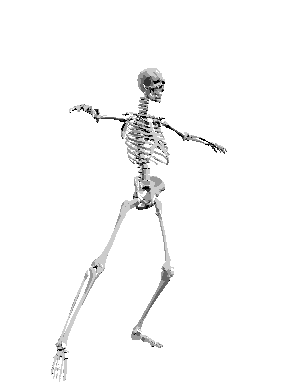Life Drawing
Lesson I
Gesture -- The Foundation of Figurative Art

Look at the same gestures, only now as a skeleton.

The skeleton is the foundation of human form and movement.
While we can't see much of it in living people, the skeleton plays a critical
role in organizing the shapes, bends and twists of the body.
Because of this, rather than just draw what you see of the external structure,
I recommend that you first draw what is inside, a stick-like skeleton. Once
you get used to this way of thinking, you can start with other approaches,
but use the skeleton reference as a helpful guide any time you want to.

Gesture Intro Page  Skeletal
Foundation
Skeletal
Foundation 
Stick: The following
are the key elements for organizing a "stick" figure:
The line of action  Three
ovals -- Head, Ribcage, Pelvis
Three
ovals -- Head, Ribcage, Pelvis  Pivot
points
Pivot
points  Long bones
Long bones  Tilts and angles
Tilts and angles  Contour
center lines of front and back torso, and face
Contour
center lines of front and back torso, and face 
Projection
and volume augmentations: While good as a foundation, the stick
figure does not adequately express projection of form, volume, or relative
position in space. There is more you can do to express these important factors
in the posing model:
The shortcomings of the stick figure  Showing projection
Showing projection  Application
of the projection concept to the stick figure
Application
of the projection concept to the stick figure  Simple
volume solutions
Simple
volume solutions  Relative
position in space
Relative
position in space 
Loosen up: Using
the stick figure foundation with the projection and volume augmentations,
you can loosely organize an expressive gesture sketch:
Compare the "contour" method to the
stick-start method  Importance
of the free-going mark
Importance
of the free-going mark  The line of
action and stick are construction lines
The line of
action and stick are construction lines  Adding
relationship and rhythm
Adding
relationship and rhythm
What's New? | Shortcut
Entrances: | Studio
| Alzofon Art Institute | Guest
Wing, Link Room | Idea
Library | Academy |
Rebecca Alzofon
can be e-mailed at rebecca@art.net
This page created February 14, 1998
 1998 by Rebecca Alzofon. All rights
reserved.
1998 by Rebecca Alzofon. All rights
reserved.
